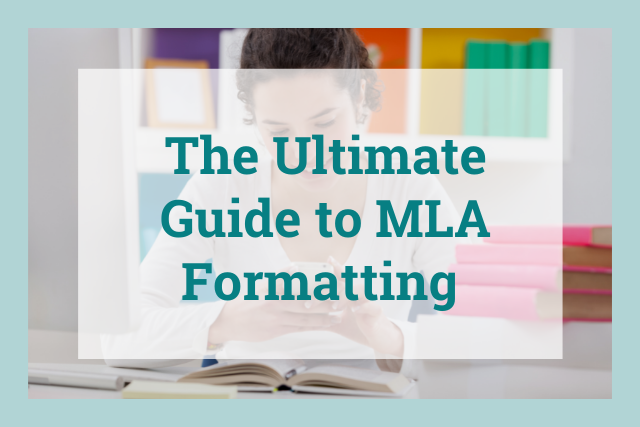
So you need to create an MLA heading? You’re not alone—MLA format is one of the most common styles you’ll be expected to use when you’re writing a humanities paper, whether you’re a high-school student or a PhD candidate.
Read on to learn what a correct MLA heading looks like and how to create one that works like magic.
What Is an MLA Heading?
The term “MLA heading” refers to five lines of important information that appear at the top of the first page.
Here are two examples of what an MLA heading could look like:
Example 1
Hermione Granger
Professor McGonagall
Transfiguration—6th period
18 October 1991
“How to Turn A Matchstick into a Needle”

Example 2
Harry J. Potter
Prof. Remus Lupin
Defense Against the Dark Arts
4 March 1994
“Why I Think My Professor Is a Werewolf”
Why are these headings important? Well, your teacher probably collects hundreds of papers every year. If any identifying information is missing from these assignments, grading and organizing them becomes much more of a challenge.
MLA headings ensure that all key information is presented upfront. With just a glance at the first page, your teacher can easily figure out who wrote this paper, when it was submitted, and which class it was written for.

What Are the Parts of an MLA Heading?
An MLA heading should include:
- Your name
- Your instructor’s name
- The name of the class
- The date the assignment is due
- The title of your paper
Your instructor may give you specific guidelines about how much detail to include in each line. For example, some teachers may ask you to refer to them by their titles, while others may ask you to use their full names. If you haven’t been given any specific instructions, don’t sweat it—any option is fine as long as it’s clear and consistent.
How Do You Format an MLA Heading?
Follow these formatting rules for your MLA heading:
- Start each piece of information on a separate line
- Don’t use any periods, commas, or other punctuation at the end of the line
- Keep the heading double-spaced, in the same font as the rest of your paper
- Left-align the first four lines (they should start at the 1-inch margin on the left side of your paper)
- Center the title (it should appear in the middle of your paper)
- Make sure your title is in title case
Title case means that major words should be capitalized and minor words should be lowercase. Major words include nouns, verbs, adjectives, adverbs, pronouns, and any word longer than four letters. Minor words include conjunctions, prepositions, and articles.
Tip: Remember that Hermione’s “Society for the Promotion of Elfish Welfare” shortens to S.P.E.W., not S.F.T.P.O.E.W—only the major words are capitalized!

What Is an MLA Header?
The MLA heading should only appear on the first page of your paper. But wait, you’re not done yet! In the rest of your paper, you need to include something called an MLA header at the top right corner of every page.
Think of the MLA header as a short, simple “You are here” marker that shows the reader where they are in the paper. By looking at the MLA headers, your instructor can easily understand where each page goes and which paper it belongs to.
What Are the Parts of an MLA Header?
The MLA header consists of your last name and page number.
For example, the second page of Hermione Granger’s essays would be labeled “Granger 2”, the third would be labeled “Granger 3”, and so on.
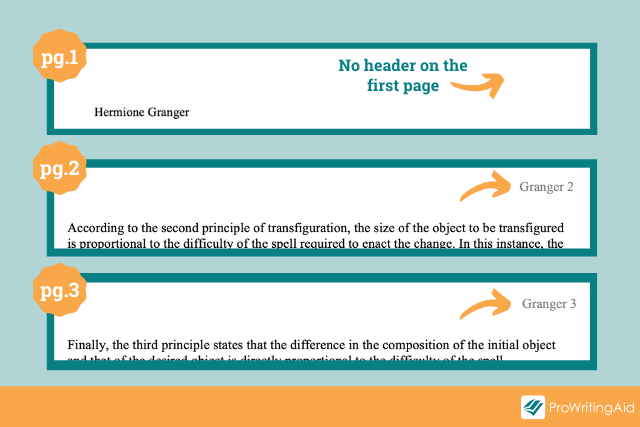
How Do you Format an MLA Header?
Creating MLA Headers in Microsoft Word
If you’re writing your paper in Microsoft Word, follow these steps:
- Click Insert
- Scroll down to Page Numbers and click on it
- Set the position to “Top of Page (Header)”
- Set the alignment to “Right”
- Make sure there’s no checkmark in the box for “Show number on first page”
- Click “OK”
- Click on the page number and type your last name before the number
- Set your font and font size to match the rest of your paper, if they don’t already
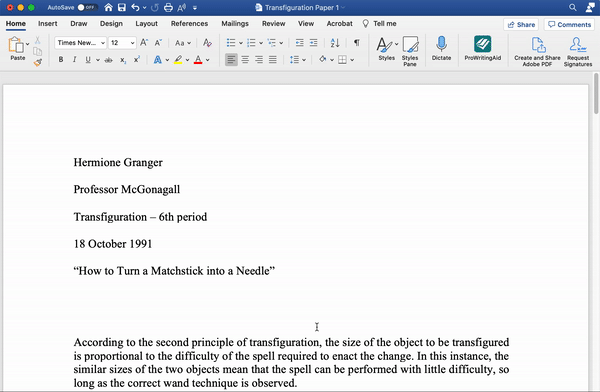
Creating MLA Headers in Google Docs
If you’re writing your paper in Google Docs, follow these steps:
- Click Insert
- Scroll down to Page Numbers and hover over it
- Choose the option that sets your page number in the upper right corner
- Click on the page number and type your last name before the number
- Set your font and type size to match the rest of your paper, if they don’t already
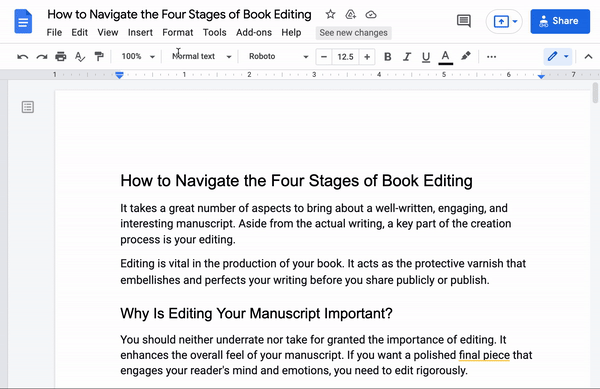
Tip: After you create your first MLA header, save a template document for yourself that you can re-use next time, so you don’t have to follow these steps every time you write a paper!
Headings Are Only the Beginning
Once you've got your headings sorted, it's time to start writing your paper. While we can't help you edit the content of your essay, ProWritingAid is here to make sure your grammar, spelling, and style is on point.
As well as checking your grammar, ProWritingAid also shows you your progress towards key goals like varied sentence structure, active voice, readability, and more. The target scores are all based on averages for real essays, so you'll always know if you're on track.
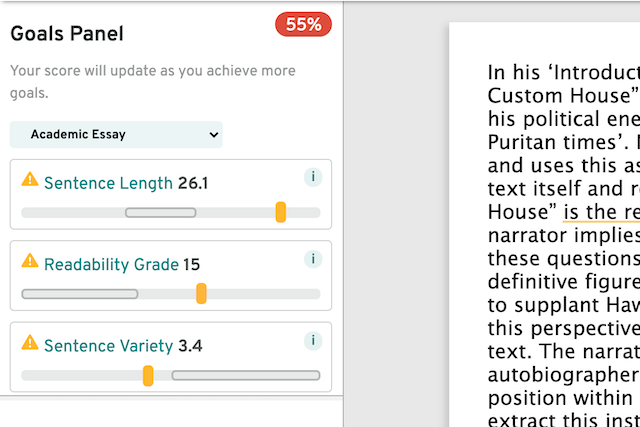
Ready to start receiving feedback before you submit your work?
Commonly Asked Questions About MLA Headers
Whose last name should you use in your MLA header if you’re writing a group paper?
The MLA Style Guide has no specific guidelines for group projects. You should always include the names of all members of the group project in the first line of your heading, but you don’t necessarily need to do this for the header on every page.
If there are only two or three authors collaborating on your paper, you can include all of your last names in the MLA header, e.g., “Granger, Potter, and Weasley 2.”
If you’re part of a bigger group and it would take up too much space to include all of your last names, you can write the name that comes first in the alphabet and then add “et al.”, e.g., “Granger et al. 2.” (The term “et al.” is short for the Latin term “et alia”, which means “and others.” You’ll often see it used in academic papers with multiple authors.)
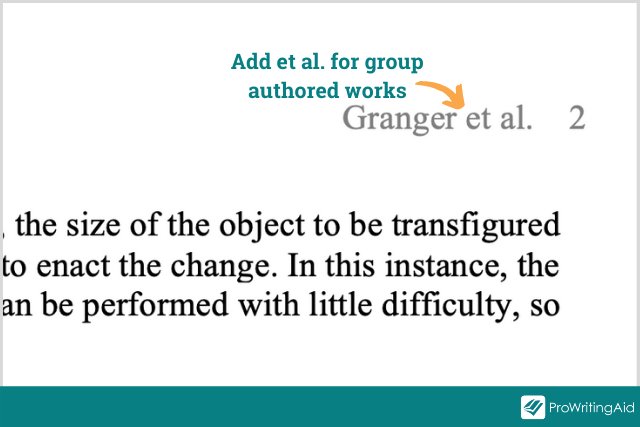
Should you include your class period in your MLA heading or just the class name?
There’s no MLA rule about this, but when in doubt, it’s always better to err on the side of including too much information in your heading rather than not enough.
If your instructor teaches more than one version of the same course, they’ll probably find it helpful if you specify the class period you’re in. You can either include your class period after the class name, e.g., “History of Magic—2nd period”, or before the class name, e.g., “2nd Period History of Magic.”
What should you write in your MLA heading if you don’t have an instructor?
If you have no instructor, you can explain the situation in the line where you would normally put the instructor’s name, e.g., “Independent Study” or “No Instructor.”
What should you write in your MLA heading if you have multiple instructors?
If you have multiple instructors, you can include both of their names in the line where you would put the instructor’s name. If you’re in a college course where you have a professor and a TA, you should choose whose name to include in the header depending on who will ultimately be reading your paper.
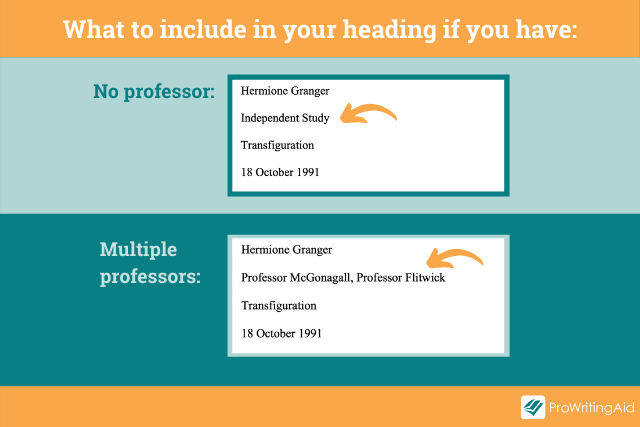
Should you include the date you started writing the paper or the date the paper is due?
The MLA Style Guide has no specific guidelines about which date you need to put in the heading. In general, however, the best practice is to put the date the assignment is due.
This is because all the papers for the same assignment will have the same due date, even if different students begin writing their assignments on different days, so it’s easier for your instructor to use the due date to determine what assignment the paper is for.
Should you format the date as Day Month Year or Month Day Year?
In MLA format, you should write the date in the order of Day Month Year. Instead of writing May 31 2021, for example, you would write 31 May 2021.
What font should you use for your MLA heading and header?
Both the heading and the header should be in the same font as the rest of your paper. If you haven’t chosen a font for your paper yet, remember that the key thing to aim for is readability. If you choose a font where your teachers have to squint to read it, or one where your teachers can’t figure out the difference between what’s italicized and what isn’t, you should rethink your choice.
When in doubt, go with Times New Roman, 12 pt. It’s always a safe bet for MLA papers unless your instructor specifically tells you otherwise.
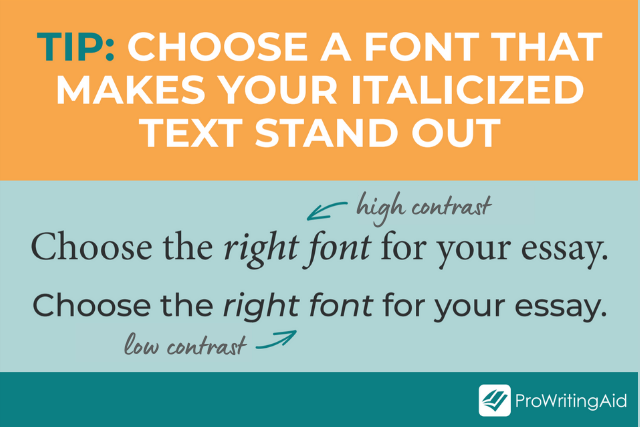
Do you need to italicize or bold the title of your MLA paper?
No. There’s no need to use any special styling on the title of an MLA paper, such as bold or italics.
How do you format section titles in your MLA paper?
If you’re writing a paper with multiple sections, you may need to include a subtitle at the top of each section.
The MLA Style Guide gives you two options for using subtitles in a paper: one-level section titles or several-level subtitles (for papers with subsections within each section).
For one-level section titles, the formatting is simple. Every subtitle should look the same as the title (centered and double-spaced, with no special formatting).
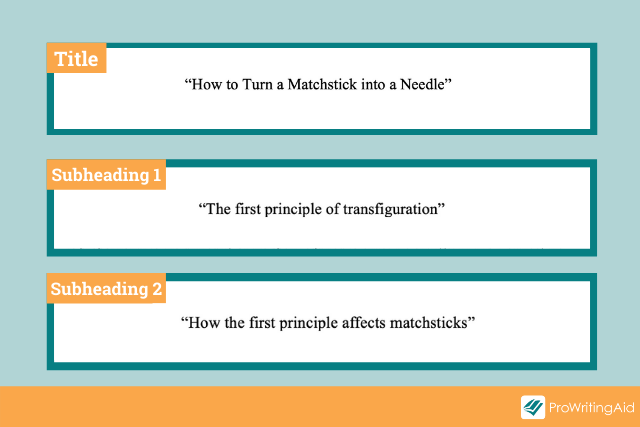
The only difference is that instead of using title case, you should capitalize only the first word of each subtitle. For example, a title would be spelled “How to Turn a Matchstick into a Needle”, while a subtitle would be spelled “How to turn a matchstick into a needle.”
For several-level subtitles, you will need to format each level in a different way to show which level each section is at. You can use boldface, italics, and underlining to differentiate between levels. For example, subtitles at the highest level should be bolded, while subtitles at the next level down should be italicized.
See the chart below for MLA’s suggested formats.
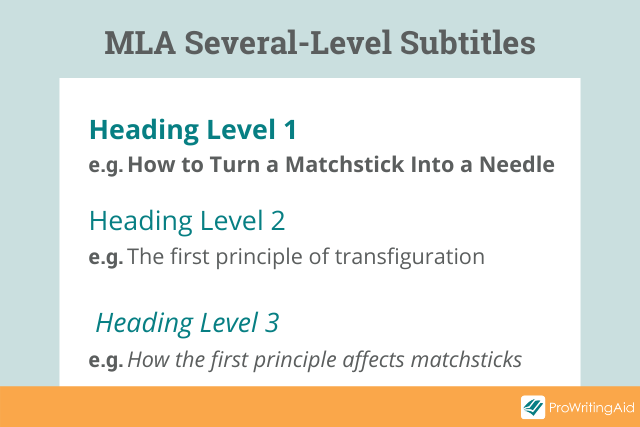
What is the difference between MLA format and APA format?
MLA and APA are two sets of guidelines for formatting papers and citing research.
MLA stands for the Modern Language Association. The MLA handbook is most often used in fields related to the humanities, such as literature, history, and philosophy.
APA stands for the American Psychological Association. The APA format is most often used in fields related to the social sciences, such as psychology, sociology, and nursing.
The APA manual includes a heading format similar to the MLA heading format with a few key differences, such as using a separate cover page instead of simply including the heading at the top of the first page. Both heading formats ensure that all of your papers include all your key identifying information in a clear and consistent way.
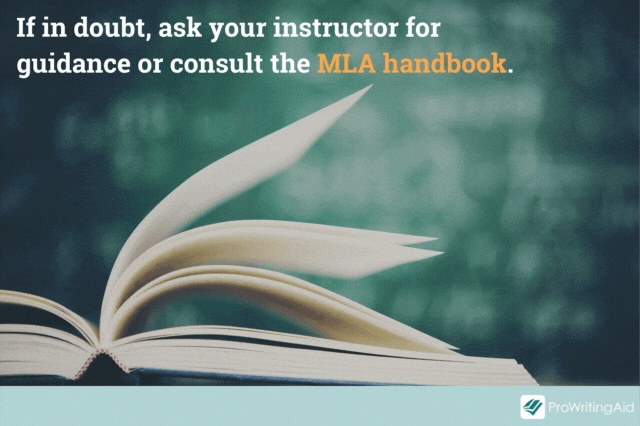
Where can you learn more about MLA style?
If you have questions about how to format a specific assignment or paper, it’s always best to consult your instructor first. Your school may also have a writing center that can help you with formatting questions.
In addition, Purdue has fantastic resources for all kinds of formatting topics, from MLA headings to MLA citations and everything in between.
If you would like to find out more directly from the Modern Language Association, consult the MLA Style Center or the MLA Handbook (8th edition).
Final Thoughts
Now you’re ready to write an MLA paper with a fantastic heading. Make sure your essay does your heading justice by checking it over with ProWritingAid.
Write Better Essays Every Time
Are your teachers always pulling you up on the same errors? Maybe you're losing clarity by writing overly long sentences or using the passive voice too much?
ProWritingAid helps you catch these issues in your essay before you submit it.


